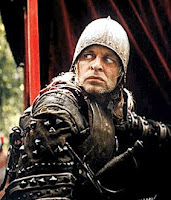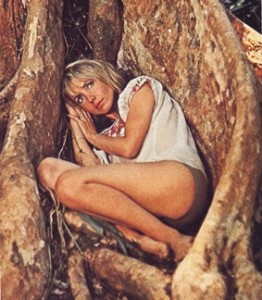We have talked — here and here — about the image of the jungle in the European imagination. Part of that mythology is that the jungle — filled with what German filmmaker Werner Herzog called “fornication and asphyxiation and choking and fighting for survival and growing and just rotting away” — has a mysterious power to drive Europeans crazy.
As famed Amazon explorer Colonel Percy Harrison Fawcett said, before his final expedition, “We will have to achieve a nervous and mental resistance, as well as physical, as men under these conditions are often broken by their minds succumbing before their bodies.” The term men presumably did not apply to those indigenous people who actually lived under the conditions he was describing.
There can be little doubt that this mythology is founded on a hierarchic colonial discourse, in which the colonial Other was seen — often contradictorily and inconsistently — as lazy, aggressive, violent, sexually promiscuous, bestial, primitive, innocent, and irrational, and the colonizers feared contamination by absorption into indigenous life and customs. But more, this colonial discourse was permeated by sexuality. Going native meant, above all, transgressive, interracial sex, with its attendant deterioration and degeneracy — the “abominable practices,” the “monstrous passions” of Kurtz in Joseph Conrad’s Heart of Darkness.
The promotional material for a recent book on Amazon exploration speaks of a history in which countless explorers, irresistibly drawn into the green hell of the jungle, “have perished, been captured by tribes, or gone mad.” Note the mythic conflation of death, madness, and assimilation into the indigenous. All three fates are essentially the same.
 |
| Klaus Kinski |
In Aguirre The Wrath of God, directed by Werner Herzog, Klaus Kinski plays conquistador Gonzalo Pizarro on a doomed quest for El Dorado, the city of gold, in the impenetrable jungles of Peru. The story is based on a historical expedition in 1650, as recorded in the journals of a priest who accompanied the mission. The conquistadors, greedy and cruel, face an environment whose cruelty is equal to their own — hostile natives, disease, starvation, and treacherous waters.
The opening shot shows a long line of men and animals snaking their way down a trail on the eastern slope of the Andes into the jungle; the final shot — one of the most unforgettable in cinema – has the camera swooping around the insane Aguirre drifting down the river on a raft filled with corpses and monkeys. In the beginning, Aguirre is rational and careful, surrounded by all the useless trappings of triumphal European civilization, carried on the backs of native porters; in the end, firing his cannon uselessly into the jungle, he is stripped of everything but transgressive sexuality, muttering about how he will conquer Mexico, marry his own daughter, and found “the purest dynasty the earth has ever seen.”
 |
| Bulle Ogier |
The Valley (Obscured by Clouds), produced and directed by Barbet Schroeder, follows a different set of European invaders — a group of hippies searching for paradise in the jungle of Papua New Guinea. The beautiful Bulle Ogier plays the bored and self-centered Vivian, married to the French Consul in Melbourne, who is in New Guinea searching for feathers of the near-extinct Bird of Paradise, which she plans to send back to Paris to sell in her boutiques. She falls in with a ragtag bunch heading for the interior to search for an unknown valley, obscured by clouds and thus invisible from the air, where the natives believe that the gods live.
What follows is not entirely clear. The feckless group heads into the jungle, Vivian has sex with the leader, they are welcomed by a primitive people wearing mud masks, they abandon their horses, and finally, at the point of death, they think they see a valley — and the movie ends.
The cruel conquistadores and the ineffectual hippies both fall prey to the madness that the jungle inflicts on Europeans. Both movies express this process in dreamy psychedelic soundtracks — by Popul Vuh in Aguirre and Pink Floyd in Valley. Both films enact the European myth of jungle madness; both sets of invaders are stripped bare, absorbed into the jungle, assimilated, finally, into primal fornication and death, gone native entirely.
It is worth taking a moment to compare the endings of the two films.

- Previous Post: The Magic Mosquito Net
- Next Post: Clean Water
- More Articles Related to: Books and Art, Jungle Survival, The Amazon



Really, from crevasses to frostbite, the Arctic Tundra can kill the unfamiliar traveler with just as much speed and impunity as the jungle, but there’s not the same romantic fascination. I can’t recall many movies about tundra madness. In fact, Herzog’s recent film about the Antarctic showcased a lot of well-grounded inhabitants. Hmm. Why is that?
That is an extremely interesting observation. The irony is increased, I think, by the fact that the tropical rainforest, when properly approached, is a relatively benign environment that readily provides food and shelter. In fact, one of the reasons for the apparent poverty of the Amazonian peoples — that is, their lack of durable tools and goods — is that it is often easier to make, say, a basket out of readily available materials, which I have seen done in about a minute and a half, than it is to keep one.
If I had to guess at a reason, I would think that perhaps a significant stressor for Europeans in the jungle is the almost complete lack of a visible horizon. And, of course, insects. :-)
In a way, the arctic does not suffer fools at all. Perhaps the jungle suffers fools just enough…to let them suffer.
Coming from the high desert of Colorado to the jungle I was struck by how visible the process of death and decay is in the jungle. I can understand how that might cause some psychological discomfort especially combined with culture shock and isolation.